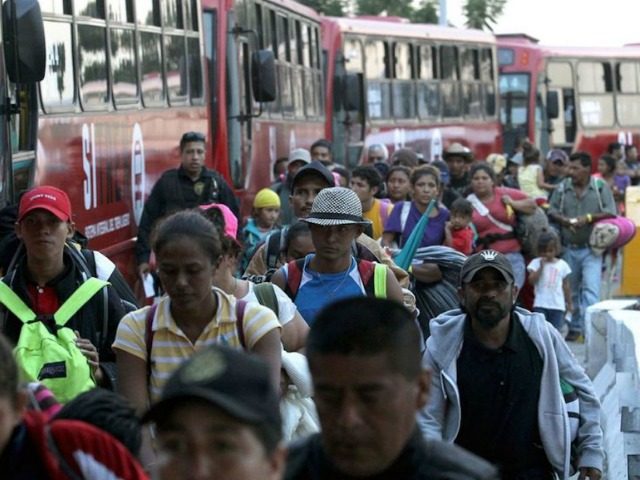Migrants walk 2,000 miles from Central America to the U.S. border, Sen. Bernie Sanders claimed during the July 30 Democrat debate.
“If a mother and a child walk thousands of miles on a dangerous path, in my view, they are not criminals … We’ve got to ask ourselves, “Why are people walking 2,000 miles to a strange country where they don’t know the language?” Sanders claimed during the debate.
In reality, migrants take a cartel-run bus service or rely on their smugglers’ mix of trains, trucks, cars, and buses.
For example, CNBC reported April 29 “the Rand study [of the coyote networks] found that human smuggling can involve taxis, charter buses and tractor-trailers that ferry migrants from the Northern Triangle to locations further north on the journey to the U.S.-Mexico border.”
The Associated Press reported one group’s travel on July 30:
In Chiapas state, a waiting minibus took them a few miles (kilometers) up the road, where they met another minibus. The latter drove ahead to detect checkpoints, since Mexico has boosted police, military and national guard in the area to crack down on migration.
…
a new law bars bus companies from selling tickets without proper IDs. So the group of eight was sent by taxi to the city’s outskirts, where the coyotes stopped a bus and they got on.
“They paid the driver,” René said. “It seemed like they knew him, because here everybody is in the same racket. Everyone asks for money.”
Bus terminals in the north are full of cartel lookouts. Sometimes they just keep an eye on comings and goings. But other times they will brazenly ask migrants where they’re from and whether they have relatives in the United States, demanding to review social media profiles to see whether they’d be worth kidnapping for ransom — an ordeal René’s family was spared.
A December 2014 report said:
After arriving in Tapachula, Pedro decided to pay for private transport to Arriaga in order to avoid the various migration police checkpoints in the region.
An old friend charged them $677 to take them 250 kilometers by car. “If you’re in a car, you don’t get stopped by migration,” said Pedro.
When they reached Arriaga, Pedro and Miguel climbed on board the Tijuanero, as the buses traveling from southern Mexico to Tijuana are known in Chiapas. They are third-rate companies, lacking the permits of a regular bus line, despite traveling regularly and having offices. The Tijuanero that Pedro and Miguel boarded should have been taken out of service some time ago, since it was a ramshackle contraption without a functioning bathroom, air conditioning, or TVs, but instead it continues to travel nearly 4,000 kilometers to the northern border and back again every week.
Some of the migrants are also taking buses home after being rejected at the U.S. border, according to a July 25 report by the Associated Press:
“They have abandoned us here to get rid of us,” said Jazmin Desir, sitting on the floor of the bus terminal surrounded by her four sleeping children. The stylist and her husband, a mechanic, were waiting for relatives to send money for them to get back to Honduras, and they figured it would take two years to pay off the debt they took on to pay their coyote.
…
Two days later, with money wired from relatives, a group hired a bus to take them to the southern city of Tapachula, near Guatemala. From there they would make their way home — essentially self-deporting at their own expense, $150 (NZD) each for the 1700-kilometre journey.
“After suffering so much, this is what we long for,” said Neftalí Anael Cantillana, a Honduran teacher who was travelling with her 16-year-old son.
The transport network is needed to move the huge population of migrants from Central American to the U.S border. Since October 1, roughly 600,000 adults and 300,000 children have arrived at the U.S. border.

COMMENTS
Please let us know if you're having issues with commenting.